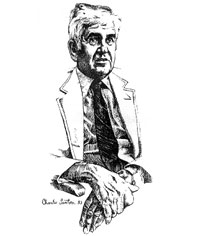
Ben Eisenstat’s teaching career began by accident. When he returned to Philadelphia at the end of World War II, he decided to seek advertising assignments to support his family while he established himself as a painter. To that end, he took his portfolio to NW Ayer and Son, where he was advised to enroll in an advertising class at the Philadelphia Museum School of Industrial Art before making the transition from fine art to commercial work.
Eager to earn a living, Eisenstat, who had attended the Pennsylvania Academy of the Fine Arts before the war, decided to return to school. When he arrived with his application, the principal, who had recently seen an exhibition of Eisenstat’s European war drawings, offered him a job. Eisenstat accepted, and for the next forty years taught at the school where had hoped to study. As time passed the institution grew and changed from a professional school, to a prominent art college, and finally in 1987 to its present status as the University of the Arts.
Mr. Eisenstat taught drawing, painting, and illustration and never saw the need to establish a distinction between applied and fine art. His own career reflected this philosophy. His illustration clients included, “The New York Times,” the “Saturday Review of Literature,” “The Philadelphia Inquirer,” Squibb Pharmaceuticals, Ford Motor Company, and NW Ayer and Son, who hired him after all, even without the advertising classes. As a painter he had thirty-two solo shows and exhibited nationally at the Chicago Art Institute, the Philadelphia Museum of Art, and the Metropolitan Museum. Eisenstat’s many honors echoed his diverse career. He won the Pennsylvania Academy of the Fine Arts’ Harrison Morris Prize three times but felt equally proud to be included in the Society of Illustrator annual exhibitions.
Students in Eisenstat’s fine art and illustration classes all learned the same principles. However, at the start of his career he felt that his illustration students, who had few opportunities to see original work, were put at a disadvantage. To remedy this, he and his wife, artist and teacher Jane Sperry Eisenstat, began to accumulate artwork from illustrators, auctions, and even yard sales. Eventually they acquired a priceless collection of more than 1500 examples of nineteenth and twentieth century illustrations.
Over the years, many exceptional students enrolled in Ben Eisenstat’s classes. Charles Santore, Jerry Pinkney, and John O’Brien are among the artists he felt privileged to teach. But it is no exaggeration to say that he admired and respected every single young person who ever made that leap of faith and decided to become an artist.
Eisenstat moved to California after he retired but continued to lecture, to share his collection, and to keep track of his former students who in his eyes remained forever young. In the late 1990’s he opened a magazine and noticed a familiar signature on an illustration. Somehow he was able to get the phone number of the artist and when he did, immediately gave him a call. “I’m so proud to see what fine work you’re doing and what a great start you’re getting,” he said. The startled illustrator who was at the end of a productive career replied, “Mr. Eisenstat, I’m on Social Security.”
Alice “Bunny” Carter Chair, Illustration Department, San Jose State University
Illustration by Charles Santore, 1983
